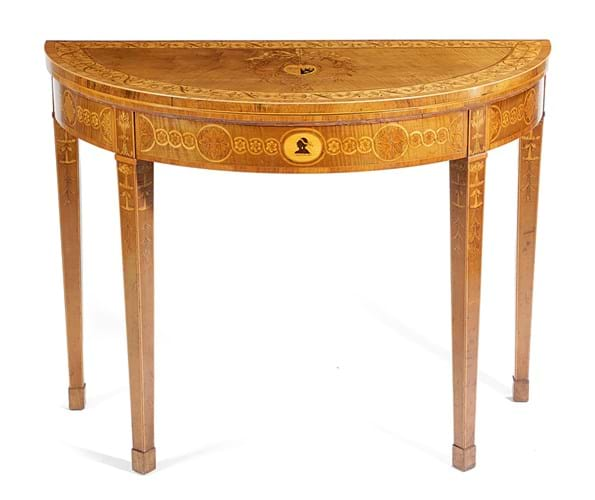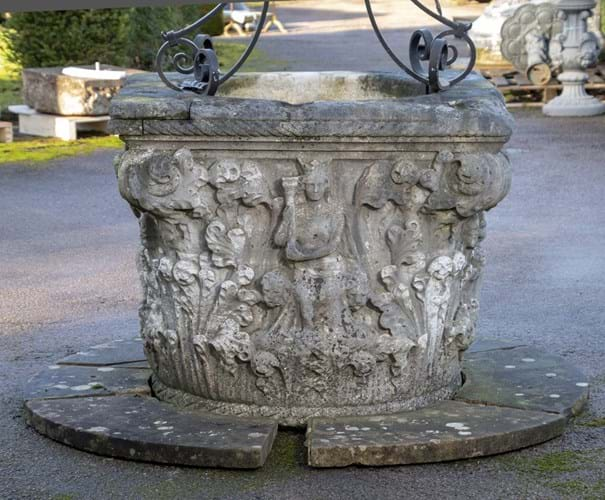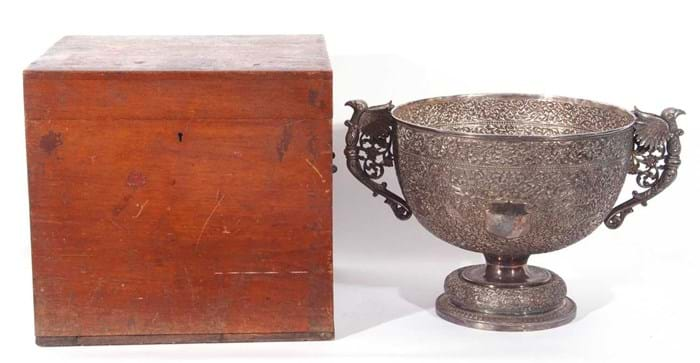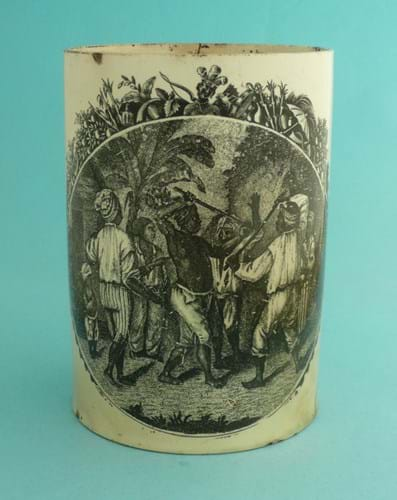1. Istrian marble wellhead – £110,000
Estimated at £25,000-40,000, this 15th century Istrian marble wellhead in the late Gothic style sold for £110,000 at Summers Place Auctions in West Sussex on March 29.
It shares much in common with a wellhead which still stands in the courtyard of the Ca’ d’Oro palazzo in Venice.
As that carving is known to have been commissioned by Marino Contarino and made by Bartolomeo Bon in Venice in 1427-28, the dozen similar surviving examples are often attributed to ’the Bon family workshops’. Most are carved with two or more allegorical figures emblematic of Fortitude, Justice, Prudence and Charity inspired by the 14th century capitals of the Palazzo Ducale.
By family repute this example (with later wrought iron overthrow and sandstone plinth) was previously in the grounds of Horton Hall, Northamptonshire, that was demolished in 1936. Once the seat of the Earls of Halifax, it is likely that the wellhead was among the many objects brought back from the Grand Tour by George Montagu-Dunk, 2nd Earl of Halifax in the mid 18th century when both the house and the garden were remodelled.
2. Cairo street scene by David Roberts – £320,000
Comfortably the top-performing lot in the Orientalist sale at Sotheby’s on March 29 was The Bazaar of the Coppersmiths, Cairo by David Roberts (1796-1864). Inscribed and dated on the reverse Street in Grand Cairo Painted for George Knott Esq 1842, this is one of the earliest of a small group of Cairo street views that Roberts painted in the 1840s. A lithograph showing an almost identical viewpoint, but with a different arrangement of figures, formed part of the artist’s great 248-plate publishing project The Holy Land, Syria, Idumea, Arabia, Egypt & Nubia.
The picture, measuring 4ft 8in x 3ft 8in (1.43 x 1.12m) has a full exhibition and extensive auction provenance (it was first sold at Christie’s in 1845 after Knott, a prosperous wholesale grocer, died) and was purchased by the vendor in 1976. Fresh to the market with a conservative estimate of £60,000-80,000, it took £320,000.
The area known to Westerners as the Bazaar of the Coppersmiths was the Sharia al-Nahhasin (Arabic for coppersmiths), part of Sharia Mu’izz id-Din Allah, the Qasaba or the great ceremonial high street of Fatimid Cairo. The building most prominent on the left is part of the façade of the 13th century Madrasa of Baybars that was destroyed in 1874.
3. Kutch silver punch bowl – £18,400
The Fine Sale at Keys in Aylsham on March 23-25 included this Kutch silver punch bowl by the celebrated Indian silversmith Oomersi Mawji & Sons, estimated at £8000-12,000. The late 19th century bowl is chased and embossed with flowers, scroll work and hunting scenes with the handles formed as winged bird’s heads. Weighing 93oz, it comes complete with its ebonised socle and a purple velvet lined travelling case.
Mawji & Sons took part in the Exposition Universelle in Paris in 1878 and sold its work in London through Liberty & Co among others at a time when exoticism was fashionable. While Mawji died in 1890, his sons continued the business until c.1930. As a fine example of the company’s work this bowl took £18,400.
4. Anti-slavery tankard – £1300
This rare creamware cylindrical tankard is printed with a copy of A Cudgelling Match between English and French Negros in the Island of Dominica by Agostino Brunias (1730-96). He had moved to the West Indian territories after the end of the Seven Years War in 1763 and made a career painting sometimes romanticised views of local life.
This particular engraving was published in February 1779 with the mug made perhaps a decade later around the time of the founding of The Society for Effecting the Abolition of the Slave Trade (1787). It thus ranks among the earliest of memorabilia produced for the anti-slavery movement.
Commemorative ceramics of this type are enjoying a purple patch in the saleroom. Despite its tired condition (there are three large hairline cracks to the base and the side) it took £1300 at Historical & Collectable of Reading on March 22.
5. George III card table – £10,000

George III harewood and marquetry card table in the manner of Mayhew & Ince – £10,000 at Woolley & Wallis
This George III harewood and marquetry card table in the manner of Mayhew & Ince includes a frieze centred with a female blackamoor bust and the inlaid arms of William Masterman of Leyton.
Masterman (1759-1845) was a banker of Quaker origins who married Lydia (1756-1819), daughter of Daniel Mildred, a merchant of London. He purchased Leyton House from the Bertie family in 1788 which subsequently became Barclay Park. The banking firm of Masterman, Peters, Mildred and Masterman was based in Lombard Street, London, between 1779-1865.
At a very different moment in the market for English furniture, a Pembroke table from the same suite that once belonged to the noted collector George D. Widener Jr was sold by Christie’s New York in 2005 for $140,000.
This card table came for sale at the Woolley & Wallis Furniture, Works of Art and Clocks sale in Salisbury on March 30. It was guided at £4000-6000 and sold at £10,000.
6. Diamond and emerald set gold pendant – £110,000

Diamond and emerald set gold pendant from the collection of Maharani Jindan Kaur – £110,000 at Bonhams.
The Islamic and Indian Art sale at Bonhams in London on March 29 included this diamond and emerald set gold pendant from the collection of Maharani Jindan Kaur (1817-63). It was one of court jewels seized by the British when they took control of the Treasury in Lahore in 1849 that were sold by auctioneers Messrs Lattie Bros in the Lahore Fort over five days from November 28 to December 2, 1850.
Many pieces were later boxed by Bombay jeweller Frazer & Hawes and sent to London for sale by Garrards of Regent Street The inside of the lid to this box is inscribed From the Collection of the Court of Lahore formed by HH The Maharajah Runjeet Singh & lastly worn by Her Highness the Late Maharanee Jeudan Kower.
Pieces such as this hold a special value in the Sikh community. As the 17th wife of Maharajah Ranjit Singh (1780-1839) and mother and regent to the young Maharajah Duleep Singh, ‘Rani Jindan’ had been a thorn in the side of the East India Company. After waging both the First and Second Anglo-Sikh Wars of 1846-49, she fled to Nepal and was not reunited with her son until 1861. By then he was living the gilded cage life of a Scottish laird.
Two pieces of Indian jewellery in similar Frazer & Hawes cases were sold at auction by Bonhams in 2018 – a pair of gold pendant earrings (£140,000) and an emerald and seed pearl necklace (£150,000) – and last year a diamond and emerald set forehead pendant (chand-tikka) sold at £105,000.
This openwork foliate pendant, probably made in Lahore in the first half of the 19th century, continued the strong series of results selling at £110,000.
7. British Railways totem sign – £3900
The classic enamel station totem signs used in the early days of the newly formed British Railways have long shown their pulling power at auction.
They appeared as part of the BR branding on nationalisation in 1948. Regional colours were adopted – light blue for Scotland. Prices can go as high as five figures for the rarest examples.
A standard 3ft (91.5cm) wide Balloch Pier sign sold in uncleaned, unrestored condition for £3900 (estimate £100-200) at Lindsay Burns of Perth on March 25.
It was offered among a large array of Scottish regional BR signs in the sale. However, closed small stations command a premium – and the fact Balloch Pier was a holiday destination probably helped. Balloch Pier station line opened in 1850 to meet steamers on Loch Lomond. However, after the last public cruise to use the pier was in 1981, the station closed in 1986.
Another Balloch Pier totem sign sold at Special Auction Services of Newbury in June 2021 for £4400.










